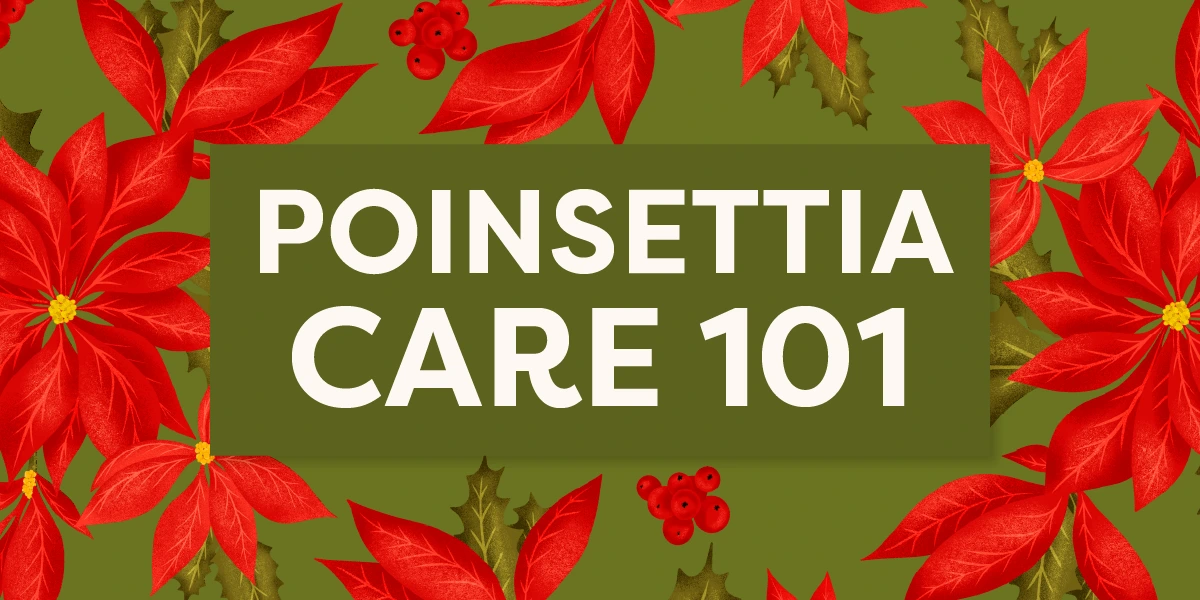Poinsettias, whose bright petal-like bracts appear in late fall, have long been the most popular Christmas plant, excluding dying Christmas trees.
Hybridization has improved the fragile poinsettia. Plants are now more colorful, and they last longer.
The red bracts that distinguish the plant are modified leaves. Modern varieties of poinsettias, of which there are over 100, include pink, white, cream, and variegated.
Poinsettias are native to tropical Mexico and Central America. The Aztecs called them “Cuetlaxochitl” and used them for medicinal purposes and decoration. Be grateful that we’ve since simplified the name.
The plant prefers warm climates and can be grown outdoors in USDA hardiness zones 9 to 11, including many California areas, especially along the coast.
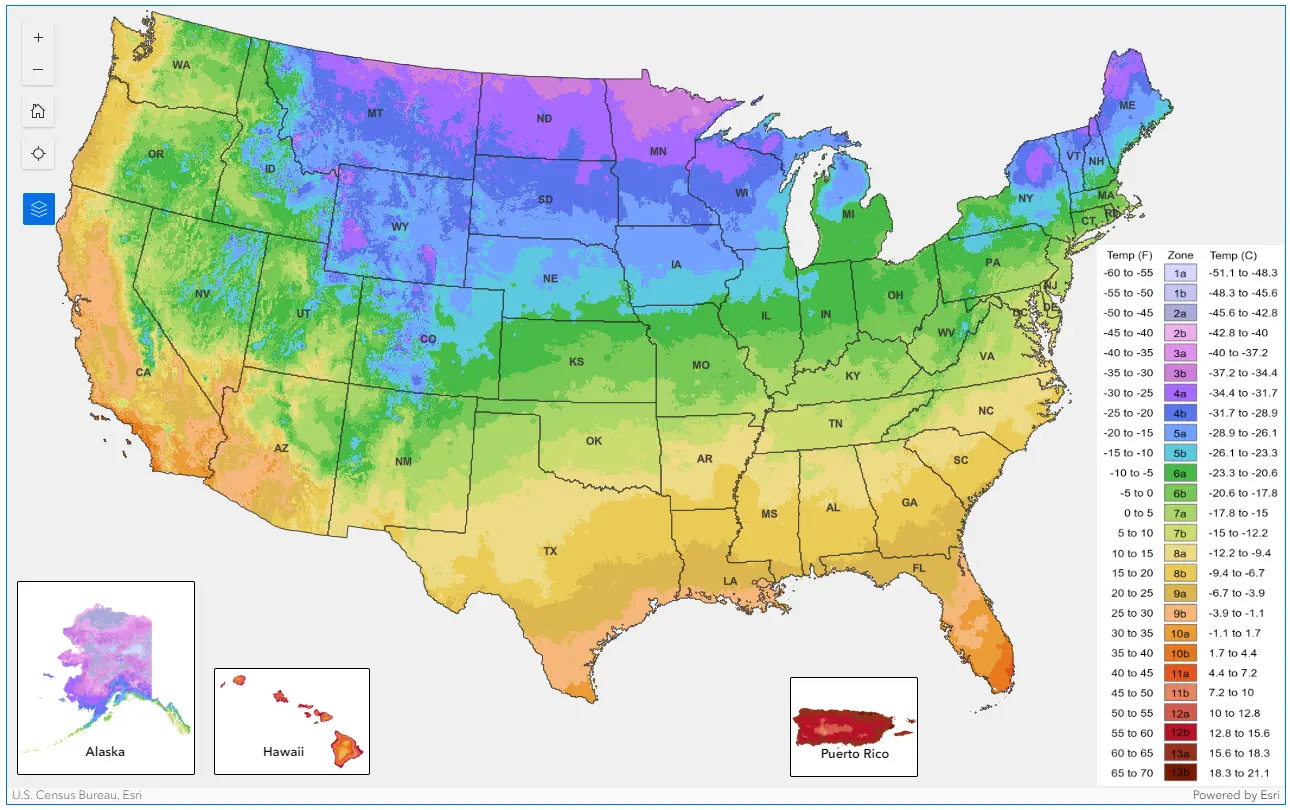
The USDA growing zones of the USA. Blue indicates cooler average colors, while warmer zones are yellow, orange, and red.
Indoor Poinsettia Care
Soil
- Poinsettias thrive in well-draining soil with a slightly acidic to neutral pH (between 5.8 and 6.5).
- Choose a high-quality potting mix specifically formulated for flowering plants.
- Consider adding perlite or sand to the soil mix for drainage.
- Poinsettias should be repotted or moved to a larger pot once a year, ideally in the spring after the blooming period.
- When repotting, choose a container 1 to 2 inches larger in diameter than the previous one to provide adequate space for development.
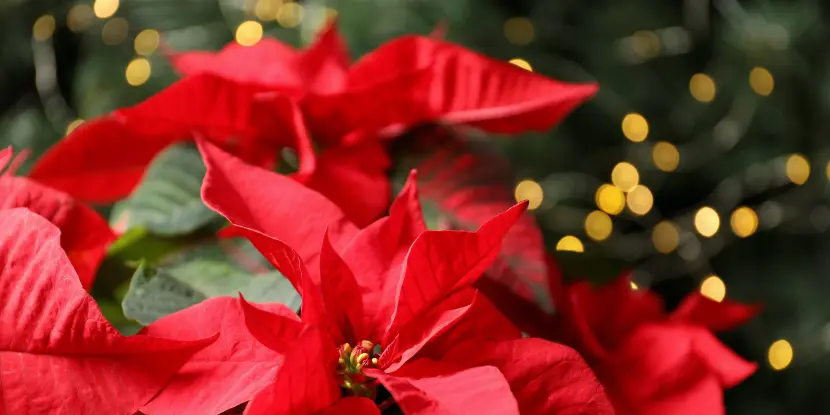
The brilliant red bracts of a poinsettia plant in bloom.
Light
- Place the plant near a south-, east-, or west-facing window where it can receive at least 6 hours of filtered sunlight daily.
- Keep the poinsettia away from direct sunlight. Intense rays can scorch the leaves.
Darkness Requirements
Poinsettias need a period of darkness to initiate blooming. This is crucial to rebloom your plant for the next holiday season.
- Starting around early October, flowers will develop only with 10 to 14 hours of uninterrupted darkness each day for forty-plus days.
- During this time, place the poinsettia in a completely dark room or cover it with a dark cloth or box from early evening until the next morning.
- The plant should receive bright, indirect light during the day’s remaining hours.
- Avoid exposing the plant to artificial light during the darkness period.
- Once the bracts have colored and the blooming cycle begins, discontinue the dark treatment and treat the poinsettia like a typical houseplant.
- Maintain a consistent light schedule during the blooming period to ensure the bracts retain their vivid color.
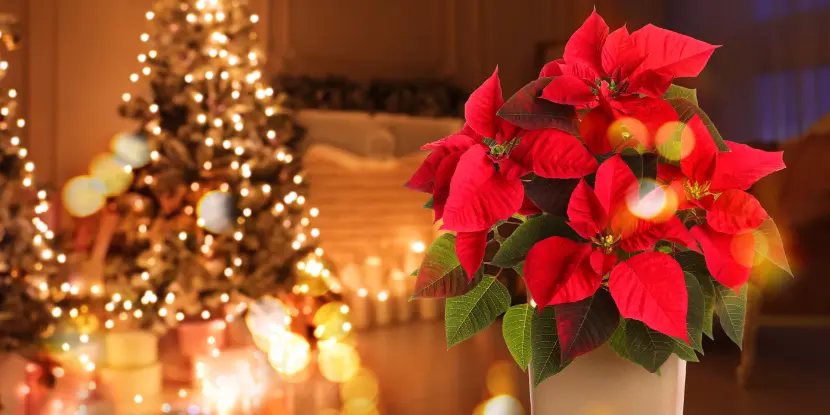
Poinsettia is the quintessential holiday plant.
Temperature & Humidity
- Poinsettias prefer temperatures between 65°F and 70°F (18°C to 21°C) during the day.
- Night temperatures should be around 60°F to 65°F (15°C to 18°C) for optimal growth and blooming.
- Avoid exposing poinsettias to temperatures below 55°F (13°C).
- Avoid placing the plant near drafts, heating vents, or cold windows to prevent temperature fluctuations that can stress the plant.
- Maintain a relative humidity level of 50% to 60% to mimic the poinsettia’s native tropical climate.
- During dry indoor conditions, especially in winter, consider using a humidifier or placing a tray with water and pebbles near the plant to increase humidity levels.
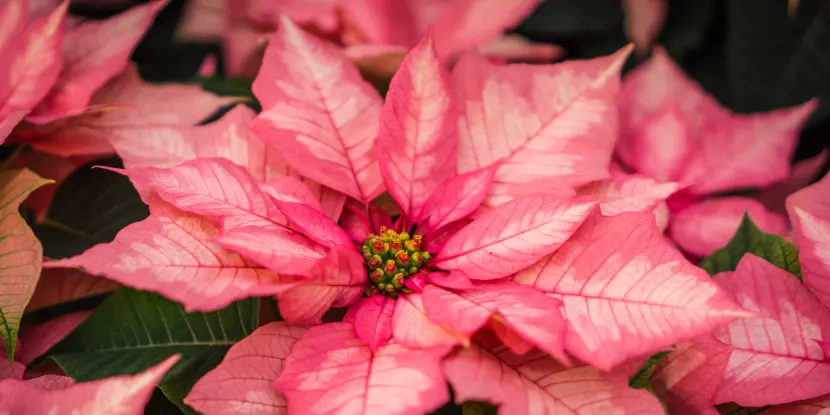
The variegated bracts of a pink and white poinsettia.
Watering Schedule
- Water poinsettias when the top inch of soil feels dry. This usually means watering every 1-2 weeks. DO NOT WATER OR MIST BLOOMS.
- Water thoroughly. Ensure the pot has proper drainage holes to prevent water from accumulating at the bottom.
- Don’t let the plant sit in standing water; empty excess water from the saucer after watering.
- When the plant’s growth slows in the winter months, reduce the watering frequency, but don’t let the soil completely dry out.
- Yellowing leaves and root rot can indicate overwatering.
- Wilted leaves, dry and brittle leaves, and decreased blooming are signs your poinsettia needs more water.
Fertilizer
- Spring and Summer: After repotting, feed the poinsettia with a balanced, water-soluble fertilizer (20-20-20) at half-strength every 3 weeks. This encourages healthy foliage growth.
- Fall: By mid-September, switch to a balanced, water-soluble fertilizer with a higher phosphorus content (15-30-15) to promote bud development and vigorous blooming.
- Winter: Once the plant begins to bloom, reduce feeding to once a month with a balanced, water-soluble fertilizer at half-strength. Over-fertilizing can lead to excessive foliage at the expense of bract coloration.
- General Tips: Always follow the instructions on the fertilizer package. Avoid fertilizing when the soil is dry – it can burn the roots. Instead, water the plant first and then apply the fertilizer solution.
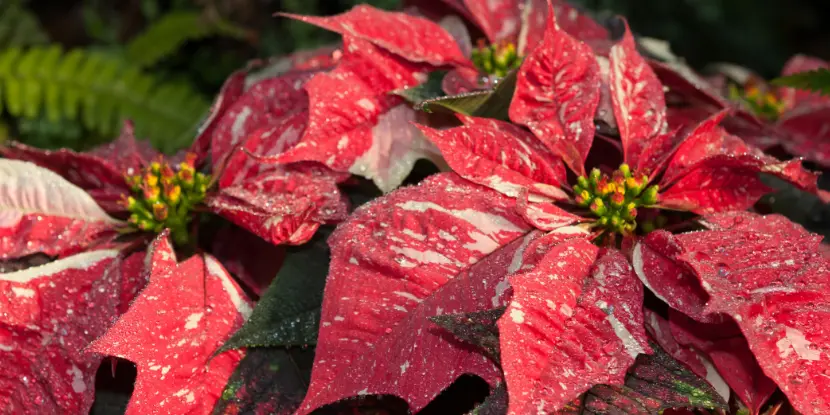
A mottled red and white poinsettia. The bracts surround clusters of tiny flowers.
Pests & Diseases
Poinsettias are generally resilient but can still be affected by pests and diseases.
Common Pests
- Aphids: Use insecticidal soap or neem oil to spray affected areas.
- Whiteflies: Deploy yellow sticky traps to capture adults. Spray a mixture of water and mild dish soap on the undersides of leaves.
- Spider Mites: Increase humidity around the plant to deter mites. Use a horticultural oil spray to suffocate the mites on the plant.
- Mealybugs: Wipe the plant with a cotton swab dipped in rubbing alcohol. Apply insecticidal soap or neem oil as a treatment.
Common Diseases
- Botrytis Blight (Gray Mold): Remove affected plant parts and ensure good air circulation around the poinsettia. Apply a fungicide labeled for botrytis control, following the product instructions.
- Powdery Mildew: Ensure the plant has adequate light and air circulation. Use a fungicide specifically designed for powdery mildew or a homemade baking soda and water spray.
- Root Rot: Avoid overwatering and ensure proper drainage. Repot the plant in fresh, well-draining soil.
- Bacterial Leaf Spot: Remove and destroy affected leaves to prevent the spread. Avoid splashing water on the leaves and water the plant at the base.
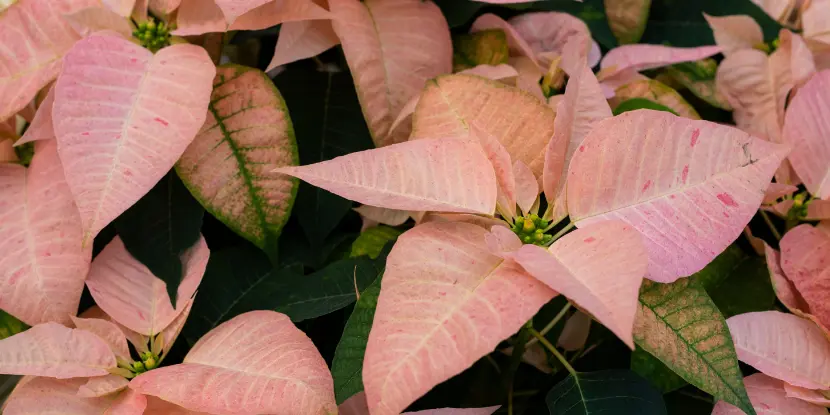
The light pink bracts of a hybridized poinsettia plant.
Pruning
Poinsettias are perennial plants that can live for several years, though older plants often lose some of their vibrancy and are more prone to developing woody stems.
Pruning encourages new growth, maintains a compact shape, and promotes blooming.
- Prune in the spring, usually in late March or early April, once the plant has bloomed and before new growth begins.
- Use clean, sharp pruning shears or scissors to make precise cuts and prevent the spread of disease.
- Cut back the stems to about 6 inches from the base of the plant. This will encourage the development of new, healthy growth.
- Carefully inspect the plant and remove any dead, damaged, or diseased parts to keep the plant healthy.
- Prune to shape the poinsettia into a fuller, more attractive form. Aim for a balanced look.
- As new growth appears, continue to pinch back the tips of the stems to encourage branching. This should be done throughout the growing season until about mid-August.
- Provide the plant with adequate light, water, and fertilizer to support recovery and growth after pruning.
FAQs: Caring for Poinsettia
Q: How often should I water my poinsettia?
Poinsettias prefer consistently moist soil; water them when the surface feels dry. Overwatering can lead to root rot, while under-watering can cause leaves to wilt and drop.
Q: What’s the best temperature to keep my poinsettia healthy?
Poinsettias thrive in temperatures between 65-70°F (18-21°C) during the day and above 60°F (15°C) at night. Protect them from drafts and extreme temperature changes.
Q: Do poinsettias need a specific type of light to flourish?
Poinsettias require bright, indirect sunlight. Direct sunlight can damage the leaves, so an ideal spot is near a sunny window with a sheer curtain.
Q: How can I encourage my poinsettia to bloom again next year?
To rebloom, poinsettias need a period of darkness for at least 10-14 continuous hours each night for 6-8 weeks in the fall. This mimics their natural light cycle and stimulates flowering.
Q: When should I fertilize my poinsettia?
Apply a balanced, all-purpose fertilizer after the blooming season, typically in early spring. Don’t fertilize when the plant is blooming.
Q: Can I put my poinsettia outside?
You can place your poinsettia outside in a shaded area during warm weather, generally above 50°F (10°C). Bring them indoors before temperatures drop in the fall.
Q: How do I deal with common pests on poinsettias?
Check regularly for pests like whiteflies and spider mites. Use insecticidal soap or neem oil to treat infestations.
Q: What’s the best way to prune a poinsettia?
A: Prune in spring or early summer to encourage bushy growth. Cut back stems to about 6 inches from the base of the plant.
Q: How do I know if my poinsettia is stressed?
Dropping leaves, wilting, or discoloration are signs of stress. This may be due to overwatering, under-watering, or exposure to extreme temperatures.
Q: Can I repot my poinsettia? If so, when?
Report your poinsettia when you notice signs of root crowding or every 1-2 years. The ideal time is in early spring, after the blooming cycle and before new growth starts.

